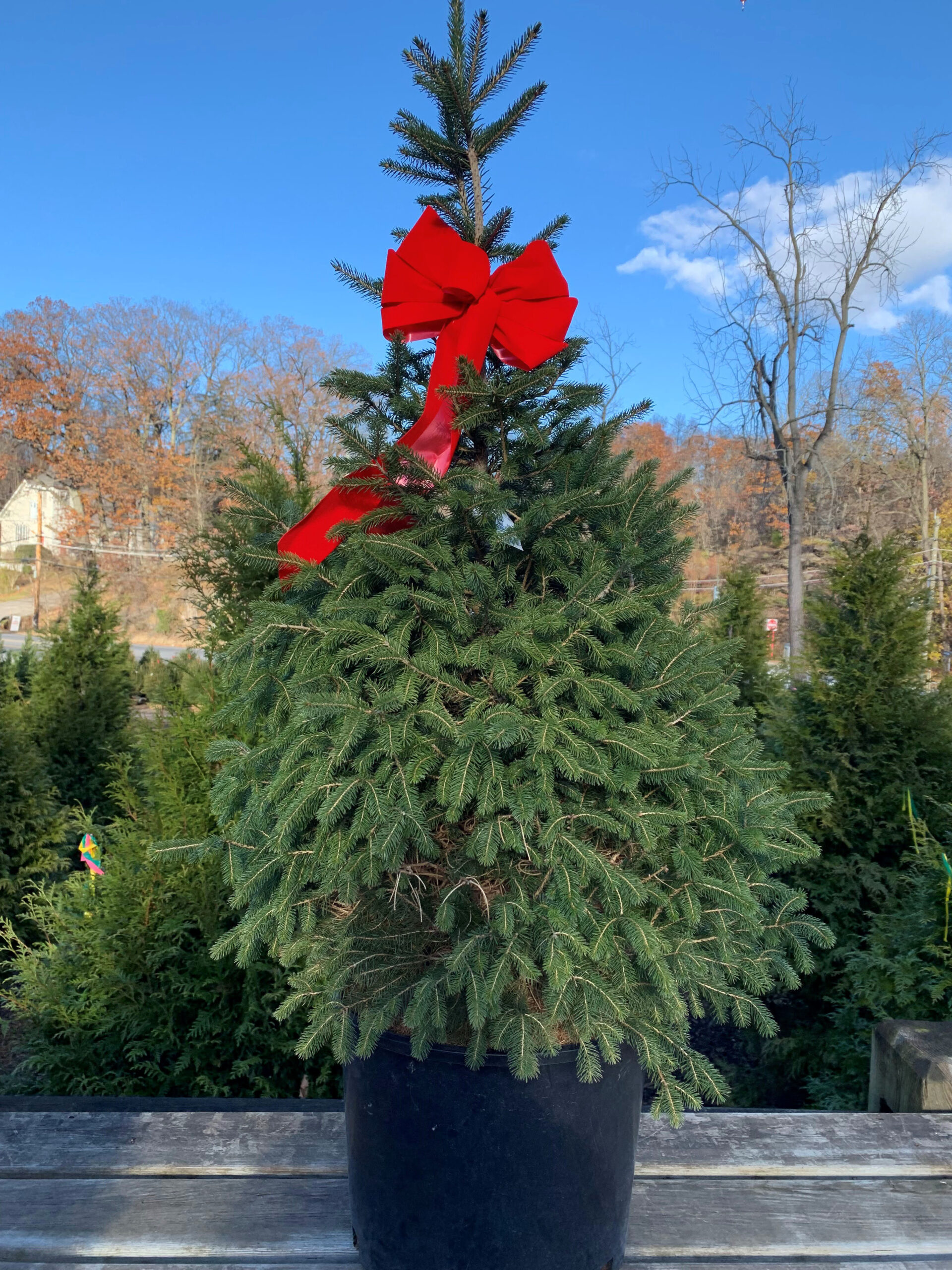Image: A potted White Spruce is ready to celebrate the holidays with you!
by Cynthia Stegman
Believe it or not, you can enjoy the beauty of a Christmas tree all year long, year after year, while also helping the environment and adding value and interest to your yard. If you are thinking of starting a new holiday tradition with your loved ones, it might be time to try out a live tree for Christmas!
As we continue to realize the consequences of “throwaway culture” and single-use products, there is one tradition that seems to have stayed under the radar: the U.S. cuts down between 30-40 million trees for use as Christmas decorations each year that are enjoyed for a few weeks and then thrown away, only for families to repeat the process each holiday season. The traditional American Christmas tree is one that has had its roots cut off and is of the “use and throwaway” variety, and unfortunately these trees are often left to rot or end up in landfills, where they release previously-trapped carbon dioxide (CO2) back into the atmosphere. The only environmentally friendly way to dispose of a cut tree is to properly mulch and recycle it so that the captured CO2 is transferred safely to the soil via the tree splinters and sawdust, instead of being released into the air.
In contrast, a living Christmas tree with its roots intact will continue to absorb CO2 when you bring it home for the holidays, and will do so as long as it is alive. Buying a living tree for Christmas supports local tree farms (reputable farmers replace each tree with 1-3 new plantings!) and helps maintain a healthy, diverse landscape in addition to helping to fight climate change and clean our air. After the holiday season a living Christmas tree can be planted in the ground or a larger container each year, and can be reused again and again as holiday decor. When planted outdoors, your living Christmas tree can continue to be decorated for the holidays with outdoor lights, natural ornaments and environmentally friendly or edible garlands.
What’s the catch with buying a Living Christmas tree?
A tree complete with roots is still a live tree, and will be conserving its strength during the cold season. In order to increase the odds of the tree surviving, these living trees can only be indoors for a week at the most, and must be slowly acclimated both into and out of the house, or they risk waking up mid-winter and stunting their growth or suffering shock in the unexpected temperature change.
Another limitation of live trees is size: the bigger and heavier the tree, the more difficult it will be to move around, and a bigger hole will need to be dug when it is time to plant it in the ground. Smaller live trees, up to about 3-4ft tall, are much more readily found and are usually in a plastic container, whereas taller living trees can be harder to find and usually have their root balls wrapped in burlap instead of a plastic container. All of the local nurseries listed below have a small selection of larger living trees, which can also be called “landscape” trees.
Lastly, living trees will cost more than cut “use and throwaway” trees: tabletop-sized specimens can cost anywhere from $10-$20, and live trees start their pricing at about $75 for a smaller, ~2-3ft tree in a container, but can be as high as $150 for a fuller tree or a specialty variety such as Dwarf Blue Spruce. Larger >5ft tall living “landscape” trees with burlap-wrapped roots are typically more expensive and range upwards from $200, and may require a truck or special transport to your home.
So what kind of tree is a “Christmas” tree?
In general, any Evergreen can be considered appropriate for Christmas and a variety’s popularity depends on the growing zone and overall climate.
The Balsam Fir and Frasier Fir are considered the “original” American Christmas trees and usually have a strong “christmas tree” scent, but these varieties may find our climate here a bit too warm to really thrive and thus are mainly sold as cut “use and throwaway” trees.
In general, Fir and Spruce trees have the shape and needle structure we tend to associate with Christmas trees in the U.S., and quite a few types are available as live trees right now: White Spruce (can grow up to 13ft tall) and Serbian Spruce (up to 5ft tall) are very similar to the “christmas tree” ideal, but if you would be interested in adding color, stunning silvery-blue needles are offered on Colorado Blue Spruce and Alberta Dwarf Spruce, which both grow up to 6ft tall.
White Fir, also called Concolor Fir, can be found for a slightly cheaper price at plant nurseries with prices starting around $50 for a small container tree, although once they are planted in the ground specimens can grow up to 100ft tall!
There are also some fun shapes and sizes for adding interest with living Christmas trees. The following list includes trees that can be bought while still small in a container, or that can be pruned to the distinct “christmas tree” pyramid shape: Cypress trees can be found in a variety of types and colors from dark green to yellow; small Holly Bushes can be pruned to a pyramid shape, and the combination of distinct spiky leaves and red berries offer visual interest; Rosemary (yes, the herb!) has recently become popular as a smaller potted “tree” alternative; Arborvitae trees have fluffy, flat leaves instead of needles and a natural pyramid shape. Additionally, both Arborvitae and cypress varieties grow nicely when planted outdoors in a row, making them great privacy screens and natural fences.
How to Choose a Living Christmas Tree?
First, choose a reasonably sized tree that is able to be moved for its designated week indoors. Moving your tree can be made easier by placing the tree’s container on a dolley, a spare length of carpet, or sturdy cardboard.
A healthy living tree should sit firmly in its soil, and have needles or leaves along the whole length of each branch with few bare spots. It is natural for there to be some brown needles thay may fall on the lowest branches near the trunk, but pass on any tree that has needles that easily fall off near the branch tips as this could be a sign that the tree is dried out or otherwise unhealthy. Lift and pick up a living tree by grabbing either its container or its root ball, but avoid grabbing it by the trunk as that can cause its roots to tear.
If you chose a live tree with a burlap-wrapped root ball, it should be placed inside a waterproof container once transported home. This could be a typical plastic pot, a repurposed wicker or metal basket, or a thrifted container: if you are unsure if your container is appropriate, line whatever you choose with plastic sheeting inside to properly seal it. Wooden chips or decorative stones can be used to help level the root ball in the container, but it should be relatively tight-fitting to prevent movement as well as moisture loss.
Once home, spray the tree with a natural antidessiccant, such as one made from pine resin, to help prevent moisture loss. Your garden center or plant nursery should also stock this spray, or be able to direct you where to buy one.
Once home, in order to prepare your tree for the holiday week indoors, it will first need a few days to acclimate to the warmer temperature inside a house. Place your living tree in a garage, shed, greenhouse or porch for five to seven days to start the acclimation process, and only then move it indoors. You may want to wait to place any delicate ornaments on the tree until it is moved indoors. Once inside, the living tree should be placed near a window and away from central heating including vents, heaters and fireplaces. Water the root ball daily, but avoid leaving any standing water.
Where to Buy a Living Christmas Tree?
Garden centers and plant nurseries have the most variety of live trees, but options can also be found at plenty of stores.
For under $30, there are plenty of local store that stock living trees on the smaller side: Stop ‘n Shop stocks live potted 1-2ft Fir trees and some pruned Holly trees in the floral section; Trader Joe’s has a selection of tabletop-sized cypresses (including the “Grinch” tree, or Lemon Cypress), italian pine trees, and even novelty rosemary trees. Home Depot and Lowes typically have live evergreen trees in 2-8gallon containers, including Dwarf Alberta Spruce and various Arborvitae, Juniper, and Cypress.
For those looking to start with a larger live tree, try plant nursery locations like Rosedale Nurseries, Westchester Greenhouse & Farms, and Hilltop Nursery & Garden Center. Here, live trees in containers as well as larger trees in burlap balls can be found, and they also have quite a bit more variety especially for smaller options: quaint ~1ft tall specimens of Euro Cypress, Lemon Cypress, and Leyland Cypress can be found for under $15, and can easily repotted into larger containers for a few years before growing too big to handle or needing to plant outdoors.
How to Care for and Plant Live Trees After the Holidays?
After about a week indoors, it will be time to transition your tree back outdoors: once more, place it in your transition spot for about five to seven days. Your tree can then be moved fully outdoors in its pot, or planted in the ground.
If you bought a live tree on the smaller side, one option is to simply replant it into a larger and larger container each year and abstain from planting it in the ground. By keeping your live tree in an appropriately sized container, it can continue to be used for multiple years as a holiday tree; simply repeat the acclimation process each year to minimize any stress, and ensure the tree has enough nutrients and light throughout the year. Of course, some tree varieties grow much larger and much faster than others, so this option may only be possible for a few years or for certain varieties.
If you decide to plant your live tree in the ground, choose a day when the landscape isn’t waterlogged or frozen, and a sunny spot where your tree has plenty of room to grow upwards as well as outwards. This can be done as early as January, or in the spring while the nights are still cool. Dig a hole the approximate height of the root ball, with a diameter at least double of the root ball, and if you have them around, add in some leaves as extra insulation. Water the tree thoroughly for some moisture before taking it out of the container, and then gently place it in the hole. If you have burlap-wrapped roots, cut away as much string and burlap as possible, to prevent the fibers from wicking moisture away from the roots. Fill the soil back into the hole up to the same point where the trunk was planted previously, and then give it another good watering; the settled soil should be level with the trunk. A few inches of mulch on top can help with insulation, but try not to place mulch within an inch or so of the trunk as that can cause fungal infections.
Investing in a living Christmas Tree creates the opportunity for years of memories, and leads to a deeper appreciation of these natural resources. Choose a unique option for your holiday celebration this year, and then choose a spot in your yard to enjoy your tree for years to come!

